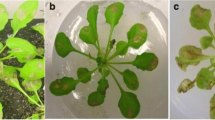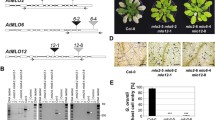Abstract
In the absence of a gene-for-gene relationship between a pathogen and its host, knowledge about aggressiveness is crucial to characterize novel pathogen populations that potentially emerge in agricultural pathosystems. Information about pathogen aggressiveness is also critical when establishing representative panels of pathogen isolates to test host resistance and in mapping quantitative trait loci involved in the host resistance. In this study, we focused on the fungus C. gloeosporioides that causes necrosis on the aerial part of one of its host plants, Dioscorea alata, and identified the in vitro conditions required to assess fungal aggressiveness on this host. Our main purpose was to convert the necrosis area development into a unique index for quantifying pathogen aggressiveness. The ‘Ag’ index described here has two advantages. First, it integrates the variance of symptom evolution curves to estimate the lesion development rates (initial and secondary) and the maximal necrosis area. Secondly, the new index takes two different symptoms commonly observed when inoculating D. alata leaves with C. gloeosporioides into account, one correlated with high leaf colonisation efficiency and the other with low colonisation efficiency. The weights accorded to each symptom in the index were proportional to leaf colonisation efficiency. We propose a framework for the acquisition of this index that has been designed to be conveniently combined with the routine bioassays required to establish representative panels of pathogen isolates. The general framework for the construction of this index can be broadly applied to diseases with necrotic symptoms.



Similar content being viewed by others
References
Abang, M. M. (2003). Genetic diversity of Colletotrichum gloeosporioides Penz. causing anthracnose disease of yam (Dioscorea spp.) in Nigeria. Bibliotheca Mycologica, Vol 197. (Berlin, Stuttgart, J. Cramer Science Publishers).
Abang, M. M., Winter, S., Green, K. R., Hoffmann, P., Mignouna, H. D., & Wolf, G. A. (2002). Molecular identification of Colletotrichum gloeosporioides causing anthracnose of yam in Nigeria. Plant Pathology, 51, 63–71.
Abang, M. M., Asiedu, R., Hoffmann, P., Wolf, G. A., Mignouna, H. D., & Winter, S. (2006). Pathogenic and genetic variability among Colletotrichum gloeosporioides isolates from different yam hosts in the agroecological zones in Nigeria. Journal of Phytopathology, 154, 51–61.
Bailey, J. A., & Jeger, M. J. (Eds.). (1992). Colletotrichum: biology pathology and control. Wallingford: CAB International.
Berner, D. K., Cavin, C. A., McMahon, M. B., & Loumbourdis, I. (2006). First Report of Anthracnose of Salsola tragus caused by Colletotrichum gloeosporioides in Greece. Plant Disease, 90(7), 971–971.
Chakraborty, S., Cameron, D. F., Irwin, J. A. G., & Edye, L. A. (1988). Quantitatively expressed resistance to anthracnose (Colletotrichum gloeosporioides) in Stylosanthes scabra. Plant Pathology, 37, 529–537.
Chongo, G., & Bernier, C. C. (2000). Effects of host, inoculum concentration, wetness duration, growth stage and temperature on anthracnose lentil. Plant Disease, 84, 544–548.
Corkidi, G., Balderas-Ruíz, K. A., Taboada, B., Serrano-Carreón, L., & Galindo, E. (2006). Assessing mango anthracnose using a new three-dimensional image-analysis technique to quantify lesions on fruit. Plant Pathology, 55, 250–257.
Degras, L. M. (1993). The Yam: A Tropical Crop. London: Macmillan Press LD.
Degras, L., Arnolin, R., Suard, C., & Poitou, R. (1984). Selection of D. alata cultivars of low susceptibility to anthracnose (Colletotrichum gloeosporioides). In F. S. Shideler, & H. Rincon (Eds.) Proceedings of Sixth Symposium of the International Society for Tropical Root Crops (pp. 627–632).
Egesi, C. N., Odu, B. O., Ogunyemi, S., Asiedu, R., & Hughes, J. (2007). Evaluation of water yam (Dioscorea alata L.) germplasm for reaction to yam anthracnose and virus diseases and their effect on yield. Journal of Phytopathology, 155, 536–543.
Flor, H. H. (1955). Host-parasite interaction in flax rust. Its genetics and other implications. Phytopathology, 45, 680–5.
Frezal, L. (2005). Etude de la diversité génétique de Colletotrichum gloeosporioïdes responsable de l’anthracnose de l’igname (Dioscorea alata) en Guadeloupe. PhD thesis, Université Paris 11, Orsay, France.
Green, K. R., & Simons, S. A. (1994). ‘Dead skin’ on yams (Dioscorea alata) caused by Colletotrichum gloeosporioides. Plant Pathology, 43, 1062–1065.
Horowitz, S. Y., Yarden, O., Zveibil, A., & Freeman, S. (2004). Development of robust screening method for pathogenicity of Colletotrichum spp. on strawberry seedlings enabling forward genetics studies. Plant Disease, 88, 845–851.
Laird, N. M., & Ware, J. H. (1982). Random-effects models for longitudinal data. Biometrics, 38, 963–974.
Luo, Y., & TeBeest, D. O. (1997). Infection components of wild-type and mutant strains of Colletotrichum gloeosporioides f. sp. Aeschynomene on northern jointvetch. Plant Disease, 81, 404–409.
Mac Donald, F. D. (1998). Yam anthracnose in the English-speaking islands of the eastern Caribbean: successes and research advances in disease management. Tropical Agriculture (Trinidad), 75(1), 53–57.
Mignouna, H. D., Abang, M. M., Green, K. R., & Asiedu, R. (2001). Inheritance of resistance in water yam (Dioscorea alata) to anthracnose (Colletotrichum gloeosporioides). Theoretical and Applied Genetics, 103, 52–55.
Mignouna, H. D., Abang, M. M., Onasanya, A., & Asiedu, R. (2002). Identification and application of RADP markers for anthracnose resistance in water yam (Dioscorea alata). Annals of Applied Biology, 141, 61–66.
Moura-Costa, P. H., Kandasamy, K. I., & Mantell, S. H. (1993). Evaluation of in vitro screening methods for assessing anthracnose disease reactions in tropical yams (Dioscorea spp.). Tropical Agriculture, 70, 147–152.
Nwankiti, A. O., Okpala, E. U., & Odurukwe, S. O. (1984). Effect of planting dates on the incidence and severity of anthracnose/blotch disease complex of Dioscorea alata L., caused by Colletotrichum gloeosporioides Penz., and subsequent effects on the yield. Beitrage zur Tropischen Landwirtschaft und Veterinarmedizin, 22, 285–292.
Onyeka, T. J., Pétro, D., Ano, G., Etienne, S., & Rubens, S. (2006). Resistance in water yam (Dioscorea alata) cultivars in the French West Indies to anthracnose disease based on tissue culture-derived whole-plant assay. Plant Pathology, 55, 671–678.
Pariaud, B., Robert, C., Goyeau, H., & Lannou, C. (2009). Aggressiveness components and adaptation to a host cultivar in wheat leaf rust. Phytopathology, 58, 409–424.
Petro, D., Onyeka, T. J., Etienne, S., & Rubens, S. (2011). An intraspecific genetic map of water yam (Dioscorea alata L.) based on AFLP markers and QTL analysis for anthracnose resistance. Euphytica, 179, 405–416.
Shaner, G., Stromberg, E. L., Lacy, G. H., Barker, K. R., & Pirone, T. P. (1992). Nomenclature and concepts of pathogenicity and virulence. Annual Review of Phytopathology, 30, 47–66.
Simons, S. A., & Green, K. R. (1994). A quantitative method for assessing the severity of anthracnose on yam (Dioscorea alata). Tropical Science, 34, 216–224.
Singh, R. D., & Prasad, N. (1967). Epidemiological studies on anthracnose of Dioscorea alata. Indian. Phytopathology, 20, 226–236.
Spielman, L. J., McMaster, B. J., & Fry, W. E. (1992). Relationships among measurements of fitness and disease severity in Phytophtora infestans. Plant Pathology, 41, 317–324.
Sutton, B. C. (1992). The genus Glomerella and its anamorph Colletotrichum. In J. A. Bailey & M. J. Jeger (Eds.), Colletotrichum: Biology Pathology and Control (pp. 1–26). Wallingford: CAB International.
Sweetmore, A., Simons, S. A., & Kenward, M. (1994). Comparison of disease progress curves for yam anthracnose (Colletotrichum gloeosporioides). Plant Pathology, 43, 206–215.
Tivoli, B., Baranger, A., Avila, C. M., Banniza, S., Barbetti, M., Chen, W., Davidson, J., Lindeck, K., Kharrat, M., Rubiales, D., Sadiki, M., Sillero, J. C., Sweetingham, M., & Muehlbauer, F. J. (2006). Screening techniques and sources of resistance to foliar diseases caused by major necrotrophic fungi in grain legumes. Euphytica, 147, 223–253.
Toribio, J. A., & Jacqua, G. (1978). Traitements fongicides contre l’anthracnose de l’igname. Nouvelle Agronomie Antilles-Guyane, 4, 147–152.
Van der Plank, J. E. (1968). Disease resistance in plants. London: Academic Press.
Wijekoon, C. P., Goodwin, P. H., & Hsiang, T. (2008). Quantifying fungal infection of plant leaves by digital image analysis using Scion Image software. Journal of Microbiological Methods, 74, 94–101.
Winch, J. E., Newhook, F. J., Jackson, G. V. H., & Cole, J. S. (1984). Studies of Colletotrichum gloeosporioides disease on yam, Dioscorea alata, in Solomon Islands. Plant Pathology, 33, 467–477.
Winch, J. E., Jackson, G. V. H., Newhook, F. J., & Cole, J. S. (1993). Blackening on yam in response to Colletotrichum gloeosporioides. Plant Pathology, 42, 187–194.
Acknowledgments
L. Frezal's work was funded through an INRA-Region Antilles-Guyane graduate research grant. We particularly thank Ivan Sache and Jean Loup Notteghem for providing scientific support, and Annabel Whibley for her advice on the manuscript.
Author information
Authors and Affiliations
Corresponding author
Electronic supplementary material
Below is the link to the electronic supplementary material.
Fig. S1
Images representing the appearance of yam leaves 11 days after inoculation. Yam leaves were inoculated with wild C. gloeosporioides isolate, leading either to pinpoint (column 2) or to typical (column 3) symptoms. The negative controls are in the first column. (JPEG 100 kb)
Rights and permissions
About this article
Cite this article
Frézal, L., Desquilbet, L., Jacqua, G. et al. Quantification of the aggressiveness of a foliar pathogen, Colletotrichum gloeosporioides, responsible for water yam (Dioscorea alata) anthracnose. Eur J Plant Pathol 134, 267–279 (2012). https://doi.org/10.1007/s10658-012-9986-4
Accepted:
Published:
Issue Date:
DOI: https://doi.org/10.1007/s10658-012-9986-4




